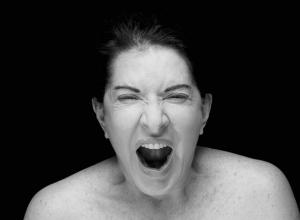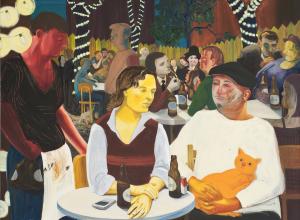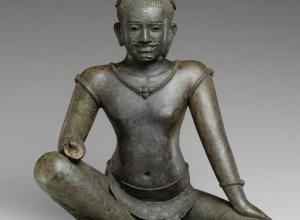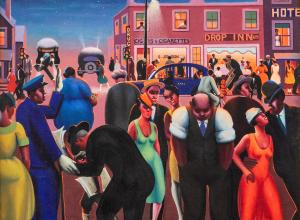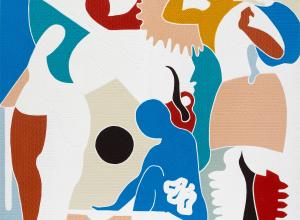The Fine Arts Museums of San Francisco (FAMSF) are proud to host the first major exhibition of Gottfried Lindauer’s portraits of the Māori, the indigenous people of New Zealand, ever assembled in the United States. A key cultural figure in New Zealand, Lindauer was one of the country’s most pioneering and prolific painters. His historical portraits of Māori leaders, community elders, warriors and politicians painted between 1874 and 1903 capture the fascinating personal stories of his subjects as well as the complex intercultural exchanges occurring at a time of great political, cultural and social change. These finely detailed oil paintings feature male and female rangatira (men and women of esteem and rank) and are considered taongas (treasures) in New Zealand.
“This unique exhibition will not only present the astonishing oeuvre of Lindauer, but will also address the complexities of what a painting is and can be,” says Max Hollein, Director and CEO of the Fine Arts Museums of San Francisco. “It is fascinating that a Czech painter, trained in the European style of 19th century portraiture became the most celebrated portraitist of Māori in New Zealand. The Māori see these paintings as ‘living connections to the past’ and the remarkable life stories of their ancestors are remembered and shared by their descendants today through these paintings.
A total of 31 portraits will be on view in The Māori Portraits: Gottfried Lindauer’s New Zealand, on loan from the Auckland Art Gallery Toi o Tāmaki and the Auckland War Memorial Museum Tāmaki Paenga Hira; many will be on view for the first time in North America.
“Lindauer’s compelling paintings of Māori are national treasures of New Zealand; we are deeply grateful to have the opportunity to show them in San Francisco.” says Christina Hellmich, Curator in charge, Arts of Africa, Oceania and the Americas and the Jolika Collection of New Guinea Art at the Fine Arts Museums of San Francisco. “They document a period when colonial settlement was forging cross-cultural interactions between the Māori—indigenous people of New Zealand—and Pākehā, their term for European settlers and their descendants. Lindauer captured the likenesses of important historical figures among several generations in his striking portraits and this exhibition pays tribute to them.”
Most of Lindauer's portraits were created posthumously and painted from photographs he collected; some were commissioned by the sitters, by Lindauer’s patrons and by others. At the time of their creation, Lindauer’s portraits were prominently displayed in private homes and marae (meeting houses) and at tangihanga (funerals), practices that continue today. They held symbolic and metaphysical meaning for many Māori in commemorating their subjects’ presence, prestige, and spirit—meanings that remain potent for their descendants. As with figurative carvings or photographs, in Māori culture, the painted images are revered and seen as powerful embodiments of tipuna (ancestors) containing mana (prestige) of the people depicted.
Lindauer took great care to convey the esteem of his sitters through the objects they hold and their clothing and personal adornments. In many of his portraits, the practice of tā moko, or tattooing, is the most visible and important statement of a person’s status and authority. Lindauer also meticulously painted sitters’ personal adornments including hei tiki (greenstone pendants) and handmade cloaks, as seen around the shoulders of Pare Watene and others. He portrayed some Māori subjects wearing military uniforms or parliamentary clothing such as Major Waata Kukutai and Hori Ngakapa Te Whanaunga. Lindauer’s paintings bring to light the role of dress and personal adornment in shaping and presenting Māori cultural identity. His paintings feature many men and women in customary Māori clothing and adornments at a time when European-style clothing and accessories were worn as daily dress by Māori and Pākēha (non-Maori) alike. Clients could select what they wore and how they were represented, but in portraits painted from photographs, Lindauer sometimes added elements or props such as feathers, cloaks and weapons.
The Māori Portraits: Gottfried Lindauer’s New Zealand is organized by Auckland Art Gallery Toi o Tāmaki, New Zealand, in collaboration with the Fine Arts Museums of San Francisco, with the support of the New Zealand Government through Manatā Taonga–Ministry for Culture and Heritage’s Cultural Diplomacy International Programme and Te Puni Kāōkiri–Ministry of Māāori Development . The curator for its presentation at the de Young is Christina Hellmich, Curator in charge, Arts of Africa, Oceania, and the Americas and the Jolika Collection of New Guinea Art at the Fine Arts Museums of San Francisco.
In Detail
The exhibition is organized chronologically following the historical trajectory of New Zealand through the personal lives of the subjects of Lindauer’s paintings. It begins with portraits of Māori women and men renowned for their remarkable life experiences in the beginning decades of the 19th century. Paintings include Te Rangipikinga, Eru Tamaikoha Te Ariari, Tamati Pirimona Marino, and Rangi Topeora portray some of these leaders. Revered chiefs represented in the paintings led their tribes during battles for land and resources after European settlement began and who acted in defiance or defense of the British colonial government during the New Zealand land wars.
A number of Lindauer’s paintings represent Māori who signed the Treaty of Waitangi, a written agreement between the British Crown and more than 500 Māori chiefs in 1840, that made New Zealand a colony of Britain and the Māori British subjects.Tawhiao Matutaera Potatau Te Wherowhero, painting of the second Māori king, will be on view, as well as representations of and others who supported the Kingitanga (Māori King movement), founded in 1858 to unite the Māori under a single sovereign.
Portraits of Māori who protested against or worked in support of the Native Land Courts and individuals who forged paths between cultures and religions include Hon. Wiremu Tako Ngatata Te Teoteo M.L.C. and Huria Matenga Ngarongoa (Julia Martin).
A section on cultural crossings features paintings of Māori who gained notoriety abroad, including Te Paea Hinerangi—known to tourists around the world as Guide Sophia. Lindauer’s best-known and admired painting is a portrait of Heeni Hirini and Child, a portraits of a Ngāti Maru woman with an infant on her back. Lindauer painted this subject more than 30 times over a period of 24 years. It was awarded a gold medal by an international jurors committee at the Louisiana Purchase Exposition, the 1904 world’s fair held in Saint Louis, Missouri; other versions were exhibited internationally in Prague and London.
Lindauer revolutionized painted portraiture in New Zealand by basing many of his representations of Māori—both living and deceased—on studio photographs. In a time before color photography, the realism of Lindauer’s portraits caused a sensation. His full range of colors achieved results that black-and-white photographs of the day could not, capturing details of the period’s clothing and adornments. These include the striking green pounamu (greenstone) adornments worn by prominent sitters and the living color of facial tattoos. The exhibition will include the film Identifying Lindauer: His Materials and Techniques, which provides insights into the artist’s practice and highlights the distinctive role of photography in his work. Also on view will be segments from Behind the Brush, a documentary series featuring interviews with descendants and experts about the lives of Lindauer’s subjects and their enduring legacies.
About the Artist
Gottfried Lindauer (1839–1926) was the most prolific and best-known painter of Māori subjects, in particular portraits, in the late 19th to early 20th centuries. He was born in Pilsen, Bohemia (later the Czech Republic), trained privately in Vienna, and migrated to New Zealand in 1874. At the time of his arrival, there were few professionally trained artists in New Zealand, which allowed him the opportunity to develop a large group of clients. He lived in his second homeland until his death. He made only three visits to Europe during this period but sent many notated drawings back to Bohemia, as well as examples of Māori taonga (treasures) and paintings. In 1901, Lindauer’s patron Henry Partridge established the Lindauer Art Gallery above his businesses on Queen Street in Auckland and opened it to the public. Partridge donated his collection of more than seventy Lindauer paintings to the city of Auckland in 1915. They are now held by the Auckland Art Gallery Toi o Tāmaki.





